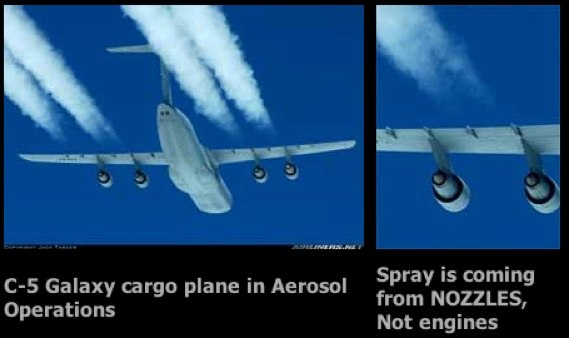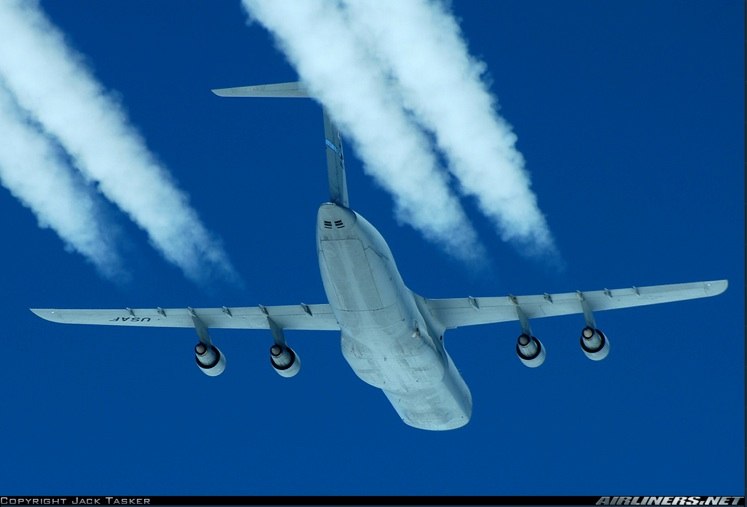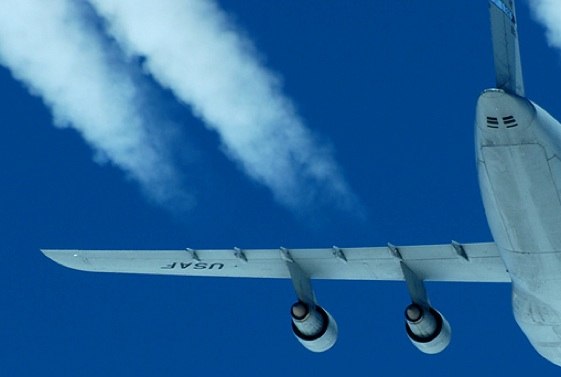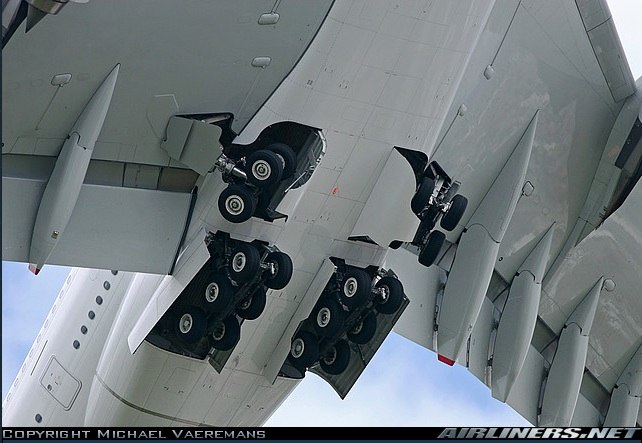Geoengineeringwatch has been using this photo since 2011, and claim it shows "spraying" from "nozzles". It does not.

That photo in their masthead is repeated below, with captions.
https://web.archive.org/web/20110429113313/http://geoengineeringwatch.org/

The original image was from Jack Tasker on Airliners.net
http://www.airliners.net/photo/USA---Air/Lockheed-C-5B-Galaxy/1347672/L/ (http://archive.is/fA0td)


The suggestions that the contrail is coming from those "nozzles" is seems pretty ridiculous. It's looks exactly like a regular contrail coming from the engine. The "nozzles" are just flap track fairings. Some of them do kind of line up with the edges of some of the contrails, so you could maybe see how someone could be taken in by the suggestion. But the trails line up with all four engines, and look exactly like exhaust contrails.
Perhaps most importantly, there's a huge gap between the engine and the contrails. This shows that what is being "sprayed" can only be water. Engine exhaust has lots of water. So every single thing points to engine exhaust, making contrails.
The original photographer, Jack Tasker, comments:
http://www.airliners.net/photo/Airbus-Industrie/Airbus-A380-861/1237902/M/ (http://archive.is/gDFtU)


That photo in their masthead is repeated below, with captions.
https://web.archive.org/web/20110429113313/http://geoengineeringwatch.org/

The original image was from Jack Tasker on Airliners.net
http://www.airliners.net/photo/USA---Air/Lockheed-C-5B-Galaxy/1347672/L/ (http://archive.is/fA0td)


The suggestions that the contrail is coming from those "nozzles" is seems pretty ridiculous. It's looks exactly like a regular contrail coming from the engine. The "nozzles" are just flap track fairings. Some of them do kind of line up with the edges of some of the contrails, so you could maybe see how someone could be taken in by the suggestion. But the trails line up with all four engines, and look exactly like exhaust contrails.
Perhaps most importantly, there's a huge gap between the engine and the contrails. This shows that what is being "sprayed" can only be water. Engine exhaust has lots of water. So every single thing points to engine exhaust, making contrails.
The original photographer, Jack Tasker, comments:
Here's some flap track fairings in operation. The fairing simply covers the flap mechanism, and also act as anti-shock bodies.
I can assure you that the contrails in the photo are in fact simply condensation from the engine exhaust. We were flying a Boeing 757 from Honolulu to Las Vegas, and met up with this C-5 about half-way to the California coast. We were 1,000 ft below the C-5 and had an excellent view as we flew past them. As a pilot who has flown airliners for 17 years, I see this sort of view all the time, and I can assure anyone that it is nothing more than vapor in the engine exhaust condensing into contrails when the atmospheric conditions are right.
We had also met the C-5 crew in our hotel lobby, as they happened to be staying in the same Waikiki hotel that we were in. They took off first, but since they cruise at only Mach 0.77 and we cruise at Mach 0.80, we caught up with them after a few hours.
http://www.airliners.net/photo/Airbus-Industrie/Airbus-A380-861/1237902/M/ (http://archive.is/gDFtU)

Last edited:


